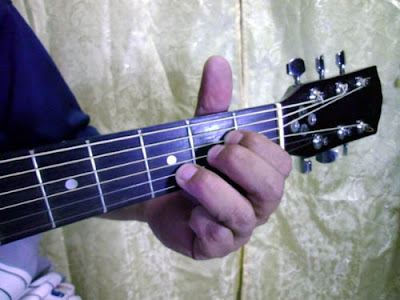CONCEPT 6
A chord "tone" includes the effect of the "free strings". The free strings are also called the "open strings", and it means the "unpressed" strings -- the strings not pressed by any finger.
In previous post, we talked about "move up" or "move down". Remember this:
if you move up, move up everything, and if you move down, move down everything.
To make this point clearer, take a look again at A-chord. As you can see, only 3 strings are marked to be fingered.
The A-chord:

But the "complete" A-chord is:

By now, You should have figured out how to press the 3 original note on the fretboard. Except the 2 "new" notes on the right, did you noticed them? Don't worry, you don't really need to press them. You cannot press at or before the nut. The notes are shown to mean "they are included in the A-chord". These are "open strings". The "X" means you should not use the string.
(
I am changing my position about including the fat-E string in A because it may be helpful to not give it so much attention at the beginning, it will have a "not so nice" repercussion in a little bit advanced chords like A/E, B/F etc. I will show derivation of these chords in a separate post.)
Let's try an example. Let's get a B from A. Remember that if I move A 2 steps up, I'll get a B?
First, start with complete A. Yes, use the "complete A" I have drawn. Moving 2 steps up (new notes in yellow, 1-arrow means 1-step or 1-fret of movement) :

Done? No, not yet. Notice the 2 notes on the right? They should move as well --
move up everything! So the whole derivation should be like:

Wait. Including the Xed string? You can ignore it for now. But probably you'll end up pressing it anyway, you'll see. Just don't use it just the same. The resulting notes from moving A's notes 2-steps up, which is B-chord, is therefore:

If you've been paying real attention, I bet you're now bewildered how the hell you're going to fret 5 notes when you only have 4 fretting fingers...yes, only 4 fretting fingers as the thumb may not be usable. Some actually use the thumb to fret on the uppermost string, but as you see, the string is X'ed. Useless.
Here's how: use your index finger to cross the fretboard and press the 2 rightmost notes simultaneously, like:

You are supposed to have enough fingers to fret B-chord now. You may have noticed now why I included the X'ed string-- as you "bar" across the fretboard with your index finger, chances are you're pressing the fat-E also. Remember: don't use it.
These kind of chords, re: chords requiring your index finger to cross the fretboard and simultaneously press notes, are called "barre chords". The beauty of barre chords is that just by moving up or down the fretboard, you'll figure out other chords.
Back to B-chord, you may see chord charts symbolizing the "crossing finger" as a simple line or arc across the fretboard, like:

That was it. If you move up, move all notes up. If you move down, move all notes down.
Finally, shown here is how to do the B-chord. Check back the
A-chord and note the common 3-notes grouped together, except that the finger assignments were changed because index finger is used to bar across the fretboard.
 Asus final:
Asus final:

















































